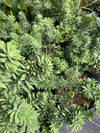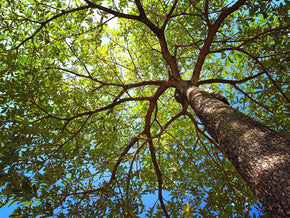If you want your garden to thrive, your plants need pollinators just as much as they need water, soil, and sunshine. In fact, 75 percent of the world’s flowering plants rely on pollinators for reproduction.
How do you attract beneficial pollinators to your garden? Grow pollinator plants these birds and insects love! Follow these tips to start welcoming more bees, hummingbirds, and butterflies into your garden.
Why Pollination is Important
Many plants need to be pollinated before they can produce flowers, fruits, vegetables, and seeds. Pollinators like birds and bees are attracted to these plants because they produce nectar. When a bird or insect gathers nectar from various flowers, they also move pollen along from one plant to the next.
Plants have both male and female parts, and pollination happens when pollen moves from the male part of the flower (the anthers) to the female part (the stigma). After it lands on the stigma, the pollen particle grows a tube that spans from the plant’s style to its ovary. The plant becomes fertilized, and it will begin to grow seeds.
Without pollinators to assist this process, many plants cannot reproduce. This is why it’s important to create a garden that attracts pollinators if you want your plants to flourish.
How to Plant a Pollinator-Friendly Garden
Thankfully, there are a few ways you can quickly start to attract more pollinators to your garden. The best way to attract pollinators to your garden is to create an environment they will love to be in.
Follow these tips to learn about how you can plant your garden in a way that will attract more pollinators. You’ll be enticing more beneficial birds and insects to visit your plants in no time.

1. Add Variety
Different pollinators are attracted to different colors. Plant a rainbow of hues, and you’ll be sure to attract a variety of different pollinators to your garden.
Bees tend to prefer blue, yellow, white, and purple hues while hummingbirds are mostly attracted to red tones. Butterflies prefer red and purple colors.
It’s also a good idea to plant flowers that bloom during different times to ensure your garden will be full of color all growing season long. Provide a variety of flower shapes as well to draw in different types of pollinators.
2. Plant in Bunches
Pollinators tend to be near-sighted. Help them find their way by planting flowers in large groups. This provides a bigger target for pollinators to hit, increasing the likelihood of successful pollination. Instead of spacing your flowers out throughout your garden, plant them in bunches of about three to five.
3. Provide Water
Birds and insects need to stay hydrated just like we do. Create a hospitable environment for pollinators by providing a source of water for them to drink. Consider adding a bird bath, shallow fountain, or small pond to help quench their thirst. They’ll thank you by becoming repeat visitors to your garden.
4. Create a Shelter
Shorten your pollinators’ commute by providing them with a place nearby to call home. Hedges, dead trees, compost piles, and unmowed grass provide great options for pollinator shelters. Try to provide at least one of these areas for them to inhabit.
You can learn more about the specific structures bees, hummingbirds, and butterflies prefer in the following sections of this article.
5. Include Trees
Certain trees make excellent pollinator plants. For instance, a maple tree or crabapple tree will provide a haven for bees when in full bloom.
If you don’t have space to plant a tree, opt for a shrub instead. Varieties like spirea, butterfly bush, and summersweet are irresistible for pollinators.
6. Use Native Plants
Native trees and plants tend to carry less risk of disease and pests than imported ones. Local pollinators are likely to prefer plants that are native to your area. Learn more about plants that are native to your specific area, and try planting some to appeal to more pollinators.
7. Allow Herbs to Bloom
Share some of the herbs you’ve grown for cooking with your pollinators. Bees in particular like herbs such as basil, dill, mint, oregano, dill, and rosemary flowers. If you can spare some of your herbs, the other plants in your garden will thank you by growing and reproducing.
8. Limit Pesticide Use
Instead of using pesticides on your plants, rely on a more natural means to ward off pests and predators if you can. Instead of relying on chemicals, let insects like ladybugs and wasps do the job of protecting your plants.
If you must use pesticides, do not spray plants when they’re in bloom, and make sure you carefully follow each instruction on your product labels.
Pollinator Plants to Attract Every Type of Pollinator
If you want to attract a wide variety of pollinators to your garden and keep them coming back, it helps to learn which types of plants attract different kinds of pollinators. That way, if you aren’t seeing a lot of butterflies, for instance, you can add some plants to your garden that are proven to attract them. Grow the following plants to increase the number of hummingbirds, bees, and butterflies in your garden.
Plants That Attract Hummingbirds
Hummingbirds are great pollinators and a joy to have in your garden. Because of their long beaks, they enjoy drinking nectar from flowers that are trumpet-shaped. They also like the colors orange, red, pink, and white.
Hummingbirds tend to build their nests on the limbs of trees or large bushes. After drinking their fill of nectar, they like to take baths in water, so it’s a good idea to provide a bird bath or shallow source of water for them.
Here are some specific flowers that attract hummingbirds:
- Bee Balm (Monarda didyma)
- Cardinal Flower (Lobelia cardinalis)
- Zinnia (Zinnia spp.)
- Salvia (Salvia spp.)
- Bleeding Heart (Lamprocapnos spectabilis)
- Butterfly Bush (Buddleia davidii)
- Trumpet Creeper (Campsis radicans)
- Lupine (Lupinus x hybridus)
- Columbine (Aquilegia spp.)
- Petunia (Petunia Group)
Plants That Attract Bees
To attract bees to your garden, add plants that are mildly scented. Bees like flowers that are yellow, blue, or white, or those that exhibit contrasting colors.

Bees live in hives, and they’re likely to construct one if they have a suitable place to do so. You could provide a bee nesting block if you have an available spot, but be cautious if you have a family member who is allergic to bee stings!
Here are some specific flowers that attract bees:
- Goldenrod
- Bee Balm
- Black Eyed Susan
- California Poppies
- Lupine
- Marigold
- Nasturtium
- Peony
- Sunflower
- Zinnia
Plants That Attract Butterflies
Butterflies enjoy lightly scented flowers as well as the colors red and purple. These insects lay their eggs in certain plants like milkweed and chokecherry. Butterflies tend to live in tree hollows or logs where there is plenty of room and safety. If you can provide such an environment, you’ll be better able to keep butterflies nearby.
Here are some specific flowers that attract butterflies:
- Phlox
- Coneflower (Echinacea)
- Lantana
- Bluestar (Amsonia Hubrichtii)
- Pot Marigolds
- Blazing Star Flowers (Liatris spicata)
- Heliotrope
- Lavender
- Swamp Milkweed
- Flossflower (Ageratum)
Tips and Tricks to Attract Pollinators to Your Garden
In addition to the plants you add to your garden, you can also install some helpful tools to increase traffic from pollinators. These extra touches will bring along even more birds and insects, giving extra assistance to your pollinator plants.
Bug Houses
You can buy artificial bug houses online and at some gardening stores. These small homes are designed to house insects like bees and ladybugs, and their structures mimic the pollinators’ natural habitats. What pollinator would say no to a brand new house?
Bird Feeders
Bird feeders are a great attraction to add to your garden. This will help provide them with enough energy to tackle a full day of pollinating your plants.
You can find simple hanging bird feeders in a variety of styles at any home and garden store. It’s also relatively simple to make your own. Be sure to include the right kinds of feed to keep pollinators coming back for more.
As you can tell, there are a variety of ways to go about attracting pollinators to your garden. Implementing some of these methods is important for keeping your plants pollinated and thriving year-round.
After planting some pollinator plants and perhaps creating some spaces and structures where pollinators can live, your garden will be buzzing with life.










